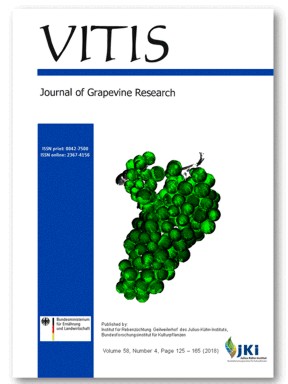Influence of foliar application of phenylalanine and urea at two doses to vineyards on grape volatile composition and amino acids content
DOI:
https://doi.org/10.5073/vitis.2018.57.137-141Keywords:
nitrogen compounds; aromatic composition; must; grapevine; fertilization; leaves application; Vitis vini- fera.Abstract
The aim was to study the effect of phenylalanine (Phe) and urea (Ur) foliar applications to vines at two dosages on grape volatile and amino acid content. Results showed that the foliar application of both dosages of phenylalanine and the highest dose of Ur favored the synthesis of the aromatic positive compounds, decreasing the presence of C6 compounds in the grapes. Total amino acid content was not modified by the treatments. The treatment that most affected the concentration of amino acids was the lowest dose of Ur, increasing the content of seven amino acids. Phe applications increased the concentration of this amino acid. Therefore, foliar treatments with Phe and Ur were a suitable tool to improve grape volatile composition without affecting grape total nitrogen content.
Downloads
Published
Issue
Section
License
The content of VITIS is published under a Creative Commons Attribution 4.0 license. Any user is free to share and adapt (remix, transform, build upon) the content as long as the original publication is attributed (authors, title, year, journal, issue, pages) and any changes to the original are clearly labeled. We do not prohibit or charge a fee for reuse of published content. The use of general descriptive names, trade names, trademarks, and so forth in any publication herein, even if not specifically indicated, does not imply that these names are not protected by the relevant laws and regulations. The submitting author agrees to these terms on behalf of all co-authors when submitting a manuscript. Please be aware that this license cannot be revoked. All authors retain the copyright on their work and are able to enter into separate, additional contractual arrangements.



